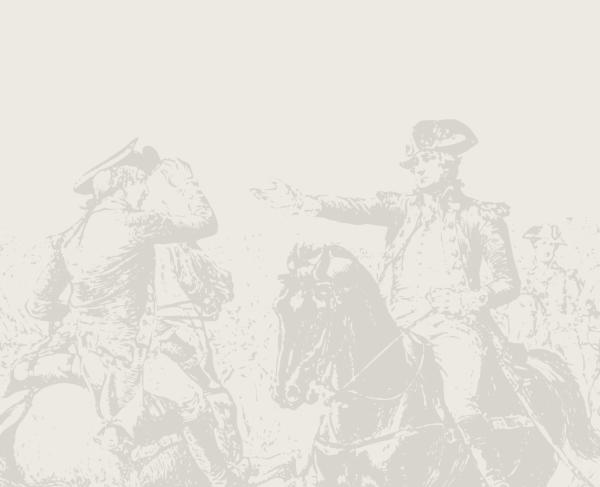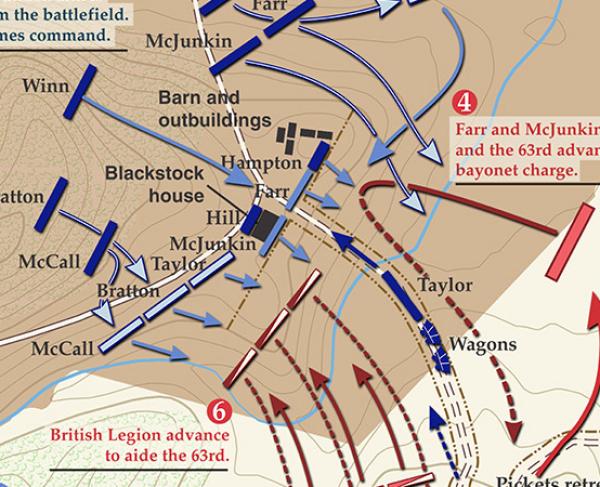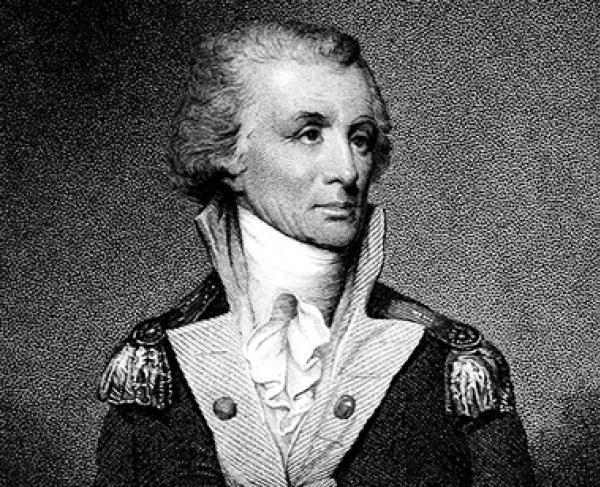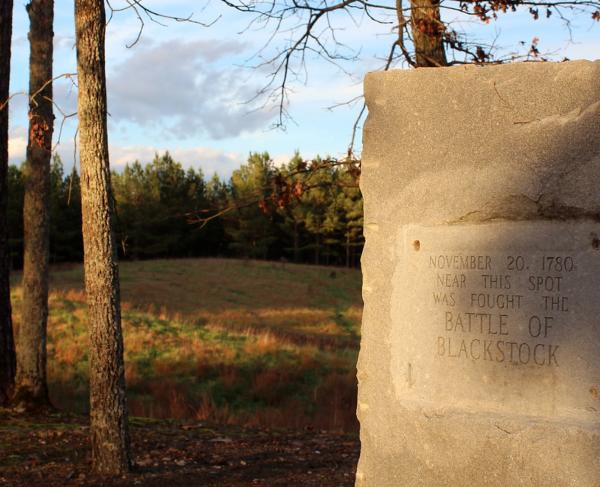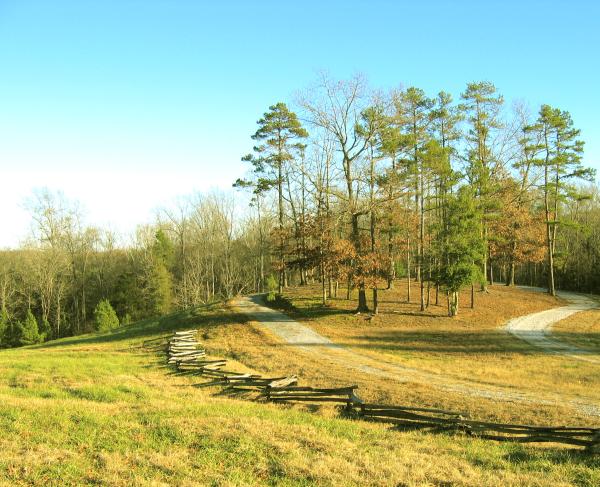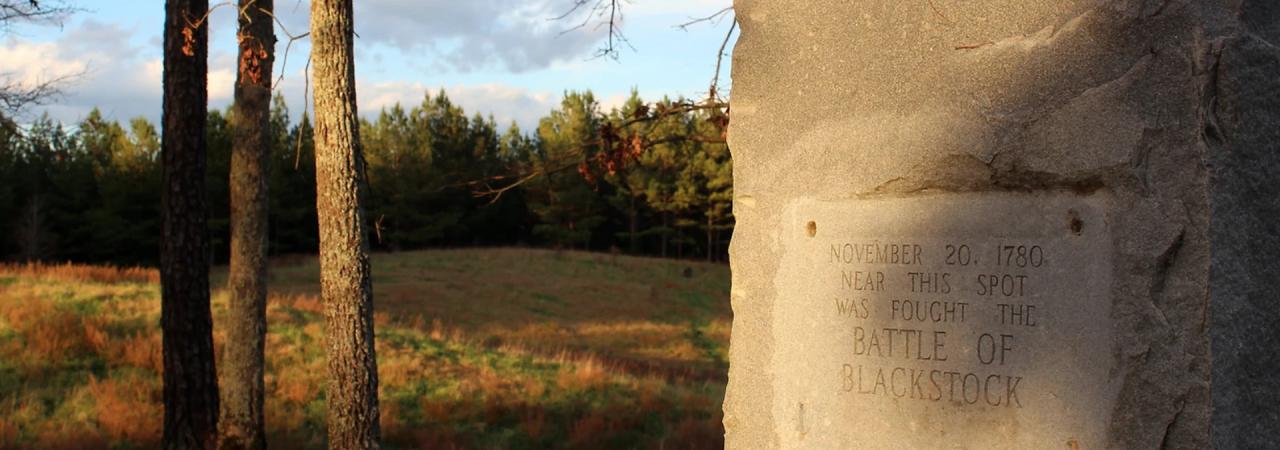
Blackstock's Plantation
Blackstock's Farm
Union, SC | Nov 20, 1780
British Lieutenant Colonel Banastre Tarleton pushed up the Enoree River with Major John Money’s 63rd Regiment of Foot and his Legion hot on the trail of Patriot Brigadier General Thomas Sumter's militia. Tarleton learned that Sumter’s army was only two hours ahead of him at Blackstock’s farm. He left behind his infantry and artillery, to move quickly with his Legion cavalry and the mounted infantry.
The Blackstock’s house, barns, and outbuildings were log-built which provided unchinked openings through which the men could fire. Situated on a sharp hill, they commanded a 50 acre pasture that sloped down to a shallow stream in the farm fields. Behind the house the land pitched sharply to the fast-running Tyger River on the north and northeast. About 200 yards to the right of the house lay a long ridge covered with a thick growth of hardwood and pine. To the left in front of the outbuildings at the top of the pasture was a strong rail fence about one-quarter of a mile long made of heavy notched saplings. This fence formed one side of a lane leading to the house.
Sumter told the troops to take post in and about the buildings. Patriot Colonel William Hill wrote “the Americans having been pursued for 2 days and nights took this ground under firm determination to defend it & not to retreat further.” Sumter placed his men around the plantation with the Tyger River to their left rear. He marshaled the troops in and about the buildings and fences under Colonels James McCall, William Bratton, Edward Lacey, Thomas Taylor, and William Hill. Colonel Henry Hampton’s riflemen were placed inside a large log barn. Down from the house and along the upper edge of the field were placed the 100 Georgia riflemen commanded by Colonel Twiggs. On the west side of this lane was a thick wood and at the mouth of this lane was placed a strong picket. To the right of the house, below a forested higher ridge, Sumter placed Colonels Edward Lacey and William Hill. Colonel Richard Winn held the reserves behind and back from the house. “That part of the hill to which the attack was directed, was nearly perpendicular, with a small rivulet, brushwood, and a rail fence in front” wrote Roderick McKenzie in his Strictures and the Patriot “left was covered by a large log barn, into which a considerable division of their force had been thrown, and from which, as the apertures between the logs served them for loop-holes, they fired with security.”
“The place Sumter selected was admirably chosen & in a military point of view could be scarcely be equaled in the vicinity. Covered by the woods and supported right and left by the hill and trees, he was able to place his untrained men in a position that would give them confidence. The gentle ascent immediately in his front would prevent an advantageous charge from the enemy,” noted Patriot militiaman Joseph Hart. On the morning of November 20, Tarleton pushed his 270 British dragoons and mounted infantry to strike at Sumter’s 1,000 partisan militia force before he could cross the Tyger River.
Major McArthur’s Highlanders appeared within 400 yards of Sumter’s position, dismounted, grounded their knapsacks on the bank of the Tyger River, and formed in the farm field. and let down the fence opposite them. Sumter noticed that the British force was divided into units - Tarleton’s British Legion, McArthur’s Highlanders, and Money’s 63rd Regiment of Foot. Tarleton may have been waiting for artillery support. Sumter started with a Georgian skirmish line at the base of the hill against the 63rd Regiment. Money dismounted his men and moved against Twiggs’ 100 Georgians placed in an advanced position. Patriot militia supported Twigg’s Georgians by attacking down the slope and across the creek. Money’s 80 regulars hit them with bayonet, through the line, driving Patriot men back up onto Sumter’s higher position. The militia fell back through the farmhouse and dependencies. As the British soldiers of the 63rd Regiment swept up and forward, they advanced too far and came under precision fire from Hampton’s sharpshooters from the log buildings. Money, personally leading the charge with his sword in hand, crumpled mortally wounded. Tarleton pranced to Money’s side and lifted him into the saddle and rode off.
Lacey’s Patriot horsemen moved around to block possible reinforcements. Lacey swung swiftly through the woods on the right to flank Tarleton’s dragoons sitting in their saddles watching the infantry fight. Lacey approached unperceived within 50 yards from the British left and opened fire point-blank with buckshot on the unsuspecting horsemen. The British Legion detachment under Lieutenant Skinner watching the 63rd charge, did not see Lacey’s mounted riflemen until they were too close. Skinner recovered to drive Lacey’s cavalry back with their sabers. Tarleton finally charged his calvary uphill against a prepared infantry position with riflemen firing from cover. So many dragoons fell from concealed Patriot fire that the lane was blocked by the bodies of these men and their fallen horses. Hill reported, “Very judiciously advanced within fire of them undiscovered, as they were then on horseback near the end of the lane [they] then gave fire so well directed that upwards of 20 of them fell from their horses as well as a number of their horses killed, the woods being so thick that the regular horse dare not penetrate it. And a number of the men dismounted occasionally crept up so as to kill many of them in their ranks.”
This battle’s seesaw action continued for hours. Hill observed, “The action commenced at one o’clock and neither horse nor foot advance to our camp between the lane & the river until the going down of the sun.” McKenzie commented that “British valor was conspicuous in this action, but no valor could surmount the obstacles that here stood in its way.” Late in the battle, Sumter spurred to watch the British maneuvering when a 63rd platoon fired a volley that hit him. Sumter was severely wounded with five buckshot in his chest and the sixth chipped his spine, lodging in his left shoulder. The British lost 92 killed and 100 wounded out of 270 men engaged. The Patriots lost three killed and four wounded. The British dead and wounded covered the farm’s fields and hills.
Sumter’s militia had fought, checked, and defeated Tarleton’s infamous Legion for the first time. Sumter, himself, was out of action for a few months but would take charge in the field again in 1781. Twiggs held the Blackstock’s farm for several hours after the battle. The British Legion lost chunks of its luster this day that it chose to frontally attack a numerically superior, better positioned enemy. Tarleton bivouacked the remnants of his command on a roadside hill two miles from the battlefield, waiting for the rest of his troops to join him. He planned to attack again the next morning. Twiggs abandoned the Patriot position during the night with decoy campfires left burning and quietly forded the Tyger River, leaving the plantation to the British. The British returned and buried the dead whilst Tarleton reported a “victory” to Lord Cornwallis. The Major General responded that Sumter was in no position to give further trouble and that the “victory” would be attended with good consequences for British affairs in South Carolina.
Blackstock's Plantation: Featured Resources
All battles of the Southern Theater 1780 - 1783 Campaign
Related Battles
1,000
270
7
192
